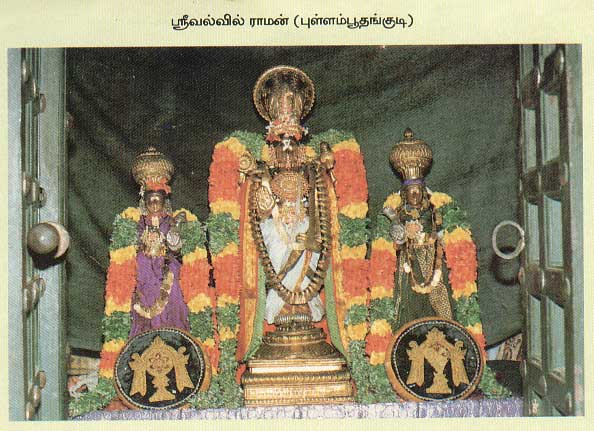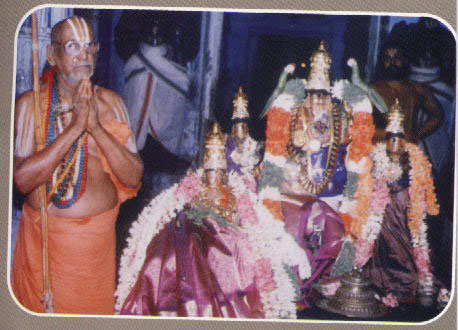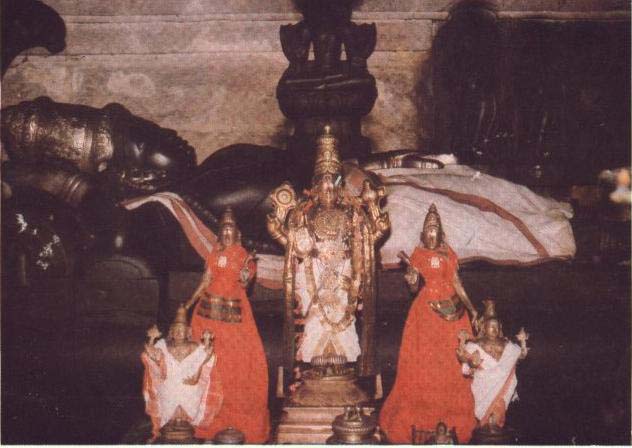lokabiramam sriramam bhooyo bhooyo namamyaham.
We prostrate to Sri Rama, the Protector of the Universe and well wisher of everyone. We have worshiped Sri Rama in many temples. He is identified by the bow He carries. Sri Andal in Her Thiruppavai [4] says rain should shower like the shower of arrows from Sarnga, the Bow of the Lord. When Sri Rama carries His bow, we are confident that we will be protected well. In Kamba Ramayana, there is a scene when Sri Sita is met by Hanuman, in Ashoka grove. Hanuman says that though he had spotted Sri Sita, to return back to report to Sri Rama about Sri Sita's condition and then to gather the monkey army and cross the ocean to reach Lanka would take lot of time. So, Hanuman suggests that if Sri Sita could climb on Hanuman's back, he would carry Her and present Her to Sri Rama immediately. Sri Sita gently refuses this idea, as it would mean some demon carried Sri Sita to Lanka and some monkey brought Her back; and Sri Rama's role will be none and be criticized. She firmly says that the responsibility for protection of Her is only of Sri Rama, and neither She nor Hanuman could do that. In Kamba Ramayana, Sri Sita says that it would not take any time for Her to curse Ravana to be reduced to ashes instantly, but protecting Her is the duty of Sri Rama alone. She was so confident of His bow. We also should have this faith in Him to rescue us from this samsaram. Though Ravana and Kumbakarna were mighty, the bow of Sri Rama was more powerful; but our sins are much more powerful, and the bow of Sri Rama should have the capacity to destroy them. That is how Sri Rama is gracing from this kshetram Pullamboothamkudi, as Sri Valvil Rama [in Tamil] and as Sri Dhruda dhanvi Rama [ in Sanskrit]. The vimanam here is called Shobana vimanam. It means auspicious and will shower all good things to the devotees. We can see Sri Yoga Narasimha here. Today's [ 12th May 2008] lecture is from beneath the sthala vruksham Punnai tree. We will now see the next sloka. Before that we will see one novel feature Thirumangai Alwar says. This place is surrounded by rivers Kaveri and Kollidam and so it is very fertile. In one pasuram Alwar ends the verse as pulluppillaikku irai thedum pullam bootham kudithane [புள்ளுப் பிள்ளைக்கு இரை தேடும் புள்ளம் பூதம் குடி தானே]. Birds are searching for food for their young ones is the meaning. Nearly 950 years back when Swami Parasara Bhattar was living and teaching these pasurams to his disciples. One of his disciples Swami Alavaiudayan, raised a doubt. Alwar says the place is fertile and the fields are full of water with large fish swimming in the water. The Disciple thought there was inherent contradiction in the verse. Alwar says large number of fish are swimming in the fields; at the same time he also states that the mother bird is searching for food for the smaller ones. This is unacceptable, thought the disciple. Swami Bhattar did not agree as the Alwar had said the right thing. No doubt many fish were there in the field and the mother bird could easily get any number. But since the fish is to be fed to smaller ones, such fatty fish would not be suitable and so it was searching for small fish suitable for the young ones! We will now see the 10th sloka:
prayana-kale manasacalena
bhaktya yukto yoga-balena caiva
bhruvor madhye pranam avesya samyak
sa tam param purusham upaiti divyam
"One who, at the time of death, fixes his life air between the eyebrows and, by the strength of yoga, with an undeviating mind, engages himself in remembering the Supreme Lord in full devotion, will certainly attain to the Supreme Personality of Godhead."
Prayana kale = in the [last] journey. We would have noticed that all these three types of devotees are required to practice Bhakti for attaining their desired objective and this should continue till their last breath. We are seeing what an aiswaryarti should do. He should desire to possess the great wealth equal to what lord Brahma has. So, as told in the last sloka, this person should think of the Lord as possessor of very great wealth, so that he can get wealth comparable to lord Brahma's. Acalena manasa = unperturbed mind, that is not aspiring for inferior rewards. Yoga balena = with the strength of Bhakti, yukta = supported,bahktya = bhakti, this is what He told in the last sloka. Bhakti and constant practice to be continuously performed. This thought in the death bed in the last hours of life is necessary; but this is possible if the person had been practicing Karma yoga uninterruptedly earlier. Otherwise, in the last moments it would not be possible to remember the Lord. Bhruvo = the two eye brows, madhye = between them in the middle, pranam = pranan, should be brought in for concentrating. This condition is a must for aiswaryarti only. Sa = such a person, tam = should meditate on the Lord, param purushan = Suprema Lord, upaiti = attains, divyam = in a superior way. He doe not reach Vaikuntam, as we are talking about aiswaryarti and so he attains the wealth he desired. We have to link with last sloka, where the person who thinks and meditates on the various qualities of the Lord. That person should bring the pranan amidst the eye brows and meditate on the Lord, in the final hours of life. He attains wealth equal to the greatest possessed by lord Brahma. We will now take leave of the temple and pray for the continued excellent management of Sri Ahobila mutt and move on to the next Kshetram.



No comments:
Post a Comment